Numerical Research of Pump-as-Turbine Performance with Synergy Analysis
Abstract
1. Introduction
2. Model Description
2.1. Geometry and Mesh Model
2.2. Governing Equation
2.3. Synergy Degree and Hydraulic Performance
2.4. One-Dimensional Hydraulic Loss Model
3. Results
3.1. Grid Dependency Test
3.2. Model Verification
3.3. Sensitivity of Parameter Correlation
3.4. Internal Flow Field Analysis
3.5. Performance Prediction
4. Conclusions
- (1)
- The sensitivity index of the pressure–velocity correlation (SPV) can be used to measure the coordinated variation in pressure and velocity in the pump and PAT. The pressure change is less sensible with velocity change at higher pump rates, while the trend is generally the opposite for the PAT. Compared to the minimum SPV at the impeller, high synchronous amplitudes are obtained at the inlet and diffuser, suggesting that pressure drop can be largely eliminated by avoiding large velocity drop in these areas.
- (2)
- According to the numerical results, the best working zone of the PAT shifts to a larger flow rate compared to that of the pump mode. With increasing flow rate, the head and torque are enhanced, and the pressure distribution in both the blade surface and volute shows a more obvious gradient. In addition, the lowest static pressure appears on the suction side of the blade leading edge, making this area cavitation-prone when operated under lower back pressure of the PAT.
- (3)
- The synergy angle of the impeller surface of the pump and PAT increases with increasing flow rate. The maximum synergy angle of the outlet is obtained at the flow rate with the highest efficiency. Also, the synergy angle of the mid-plane shows a similar trend to the head variation with flow rate. For the synergy field of the PAT, a strong disordered distribution exists in regions of the blade leading edge, trailing edge, and volute tongue, indicating that proper design of these areas could be beneficial for performance improvement of the energy recovery process.
- (4)
- The synergy analysis and the sensitivity correlation analysis can be applied to quantitatively evaluate the energy transfer performance and the inherent correlation between pressure and velocity. It is also expected to provide a basis for further design improvement and selection guidance for the operating conditions of the pump and PAT.
Author Contributions
Funding
Institutional Review Board Statement
Informed Consent Statement
Data Availability Statement
Conflicts of Interest
References
- Williams, A.A. The turbine performance of centrifugal pumps: A comparison of prediction methods. Proc. Inst. Mech. Eng. A J. Power Energy 1994, 208, 59–66. [Google Scholar] [CrossRef]
- Kaunda, C.S.; Kimambo, C.Z.; Nielsen, T.K. A technical discussion on micro-hydropower technology and its turbines. Renew. Sustain. Energy Rev. 2014, 35, 445–459. [Google Scholar] [CrossRef]
- Binama, M.; Su, W.T.; Li, X.B.; Li, F.C.; Wei, X.Z.; An, S. Investigation on pump as turbine (PAT) technical aspects for micro hydropower schemes: A state-of-the-art review. Renew. Sustain. Energy. Rev. 2017, 79, 148–179. [Google Scholar] [CrossRef]
- Bai, L.; Zhou, L.; Han, C.; Zhu, Y.; Shi, W. Numerical study of pressure fluctuation and unsteady flow in a centrifugal pump. Processes 2019, 7, 354. [Google Scholar] [CrossRef]
- Jing, T.; Cheng, Y.; Wang, F.; Bao, W.; Zhou, L. Numerical Investigation of Centrifugal Blood Pump Cavitation Characteristics with Variable Speed. Processes 2020, 8, 293. [Google Scholar] [CrossRef]
- Carravetta, A.; Houreh, S.D.; Ramos, H.M. Pumps as Turbines, Fundamentals and Applications; Springer: Cham, Switzerland, 2018. [Google Scholar]
- Miao, S.; Yang, J.; Shi, F.; Wang, X.; Shi, G. Research on energy conversion characteristic of pump as turbine. Adv. Mech. Eng. 2018, 10, 1–10. [Google Scholar] [CrossRef]
- Pérez-Sánchez, M.; Simão, M.; López-Jiménez, P.; Ramos, H. CFD analyses and experiments in a PAT modeling: Pressure variation and system efficiency. Fluids 2017, 2, 51. [Google Scholar] [CrossRef]
- Yang, S.; Shahram, D.; Kong, F. Theoretical, numerical and experimental prediction of pump as turbine performance. Renew. Energy 2012, 48, 507–513. [Google Scholar] [CrossRef]
- Štefan, D.; Rossi, M.; Hudec, M.; Rudolf, P.; Nigro, A.; Renzi, M. Study of the internal flow field in a pump-as-turbine (PaT): Numerical investigation, overall performance prediction model and velocity vector analysis. Renew. Energy 2020, 156, 158–172. [Google Scholar] [CrossRef]
- Barrio, R.; Fernandez, J.; Blanco, E.; Parrondo, J.; Marcos, A. Performance characteristics and internal flow patterns in a reverse-running pump–turbine. Proc. Inst. Mech. Eng. C J. Mech. Eng. Sci. 2012, 226, 695–708. [Google Scholar] [CrossRef]
- Lin, P.; Li, Y.; Xu, W.; Chen, H.; Zhu, Z. Numerical Study on the Influence of Inlet Guide Vanes on the Internal Flow Characteristics of Centrifugal Pump. Processes 2020, 8, 122. [Google Scholar] [CrossRef]
- Binama, M.; Su, W.; Cai, W.; Li, X.; Muhirwa, A.; Li, B.; Bisengimana, E. Blade trailing edge position influencing pump as turbine (PAT) pressure field under part-load conditions. Renew. Energy 2019, 136, 33–47. [Google Scholar] [CrossRef]
- Balacco, G. Performance Prediction of a Pump as Turbine: Sensitivity Analysis Based on Artificial Neural Networks and Evolutionary Polynomial Regression. Energies 2018, 11, 3497. [Google Scholar] [CrossRef]
- Xue, P.; Liu, Z.; Lu, L.; Gao, Z.; Meng, X. Experimental Research on the Rotating Stall of a Pump Turbine in Pump Mode. Water 2019, 11, 2426. [Google Scholar] [CrossRef]
- Wang, L.; Asomani, S.N.; Yuan, J.; Appiah, D. Geometrical Optimization of Pump-As-Turbine (PAT) Impellers for Enhancing Energy Efficiency with 1-D Theory. Energies 2020, 13, 4120. [Google Scholar] [CrossRef]
- Guo, Z.; Li, D.; Wang, B. A novel concept for convective heat transfer enhancement. Int. J. Heat Mass Transf. 1998, 41, 2221–2225. [Google Scholar] [CrossRef]
- Xiao, H.; Dong, Z.; Long, R.; Yang, K.; Yuan, F. A study on the mechanism of convective heat transfer enhancement based on heat convection velocity analysis. Energies 2019, 12, 4175. [Google Scholar] [CrossRef]
- Kallin, D.; Nordenskjöld, K. Fluid-Structure Interaction Analysis of a Centrifugal Fan; Chalmers University of Technology: Gothenburg, Sweden, 2017. [Google Scholar]
- Tiwari, G.; Kumar, J.; Prasad, V.; Patel, V.K. Utility of CFD in the design and performance analysis of hydraulic turbines-A review. Energy Rep. 2020, 6, 2410–2429. [Google Scholar] [CrossRef]
- Qian, Z.; Wang, F.; Guo, Z.; Lu, J. Performance evaluation of an axial-flow pump with adjustable guide vanes in turbine mode. Renew. Energy 2016, 99, 1146–1152. [Google Scholar] [CrossRef]
- He, Y.; Lei, Y.; Tian, L.; Chu, P.; Liu, Z. An analysis of three field synergy on heat transfer augmentation with low penalty of pressure drop. J. Eng. Thermophys. 2009, 30, 1904–1906. [Google Scholar]
- Liu, M.; Tan, L.; Cao, S. Theoretical model of energy performance prediction and BEP determination for centrifugal pump as turbine. Energy 2019, 172, 712–732. [Google Scholar] [CrossRef]
- Kara Omar, A.; Khaldi, A.; Ladouani, A. Prediction of centrifugal pump performance using energy loss analysis. Aust. J. Mech. Eng. 2017, 15, 210–221. [Google Scholar] [CrossRef]
- Gülich, J.F. Centrifugal Pumps, 4th ed.; Springer Nature: Cham, Switzerland, 2020. [Google Scholar]
- Yang, J.; Ji, Y.; Lin, B.; Ma, Q.; Luo, Y.; Li, Z. Energy performance prediction of single-stage single-suction centrifugal pump under multiple operating conditions. J. Lanzhou Univ. Technol. 2020, 46, 48. [Google Scholar]
- Davidson, A.A.; Salim, S.M. CFD Modelling of Rotating Annular Flow Using Wall y+. In Transactions on Engineering Technologies; IMECS 2018; Springer: Singapore, 2019; pp. 318–330. [Google Scholar]
- Li, X.; Yuan, S.; Pan, Z.; Li, Y.; Yang, J. Numerical simulation of whole flow field for centrifugal pump with structured grid. Trans. Chin. Soc. Agric. Mach. 2012, 28, 67–72. [Google Scholar]
- Dass, A.; Gedupudi, S. 1-D semi-analytical modeling and parametric study of a single phase rectangular Coupled Natural Circulation Loop. Chem. Eng. Sci. 2019, 207, 105–129. [Google Scholar] [CrossRef]
- Computational Fluid Dynamics Committee (Ed.) Guide: Guide for the Verification and Validation of Computational Fluid Dynamics Simulations (AIAA G-077-1998(2002)); American Institute of Aeronautics and Astronautics: Reston, VA, USA, 1998. [Google Scholar]
- Al-Suhaibani, Z.A. Flow Analysis and Modeling of Centrifugal Compressor Impellers, ProQuest Dissertations. Ph.D. Thesis, Michigan State University, East Lansing, MI, USA, 2005. [Google Scholar]
- Duarte, J.; Valencia, G.; Obregón, L. Development of a CFD model to predict the thermal performance of solar collectors. Contemp. Eng. Sci. 2018, 11, 3647–3654. [Google Scholar] [CrossRef]
- Sun, X.; Ma, Y.; Liu, X.; Sun, D. Flow stability model of centrifugal compressors based on eigenvalue approach. AIAA J. 2016, 54, 2361–2376. [Google Scholar] [CrossRef]
- Matteo, L.; Dazin, A.; Tauveron, N. Modelling of a centrifugal pump using the CATHARE-3 one-dimensional transient rotodynamic pump model. Int. J. Fluid Mach. Syst. 2019, 12, 147–158. [Google Scholar] [CrossRef]
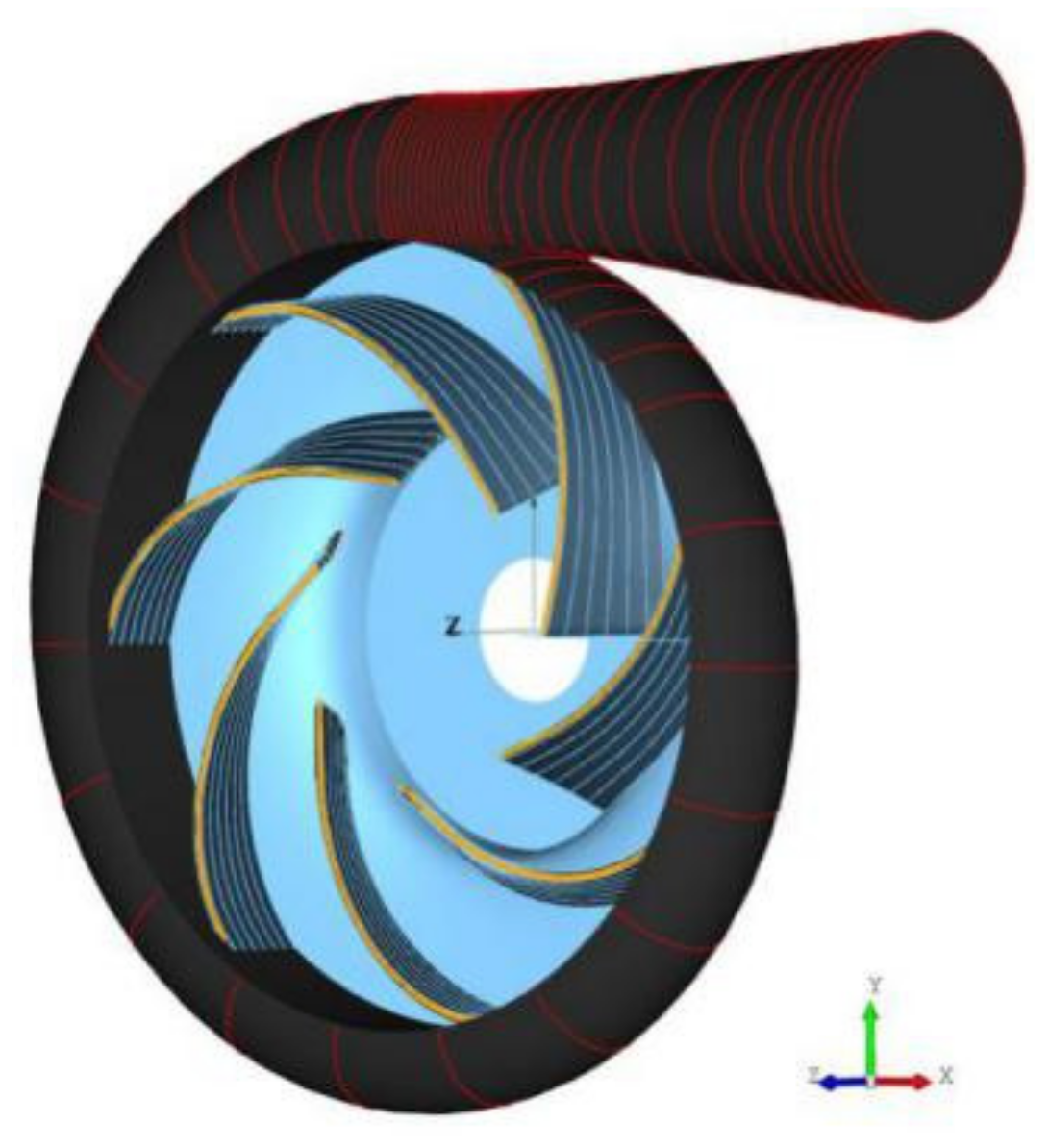

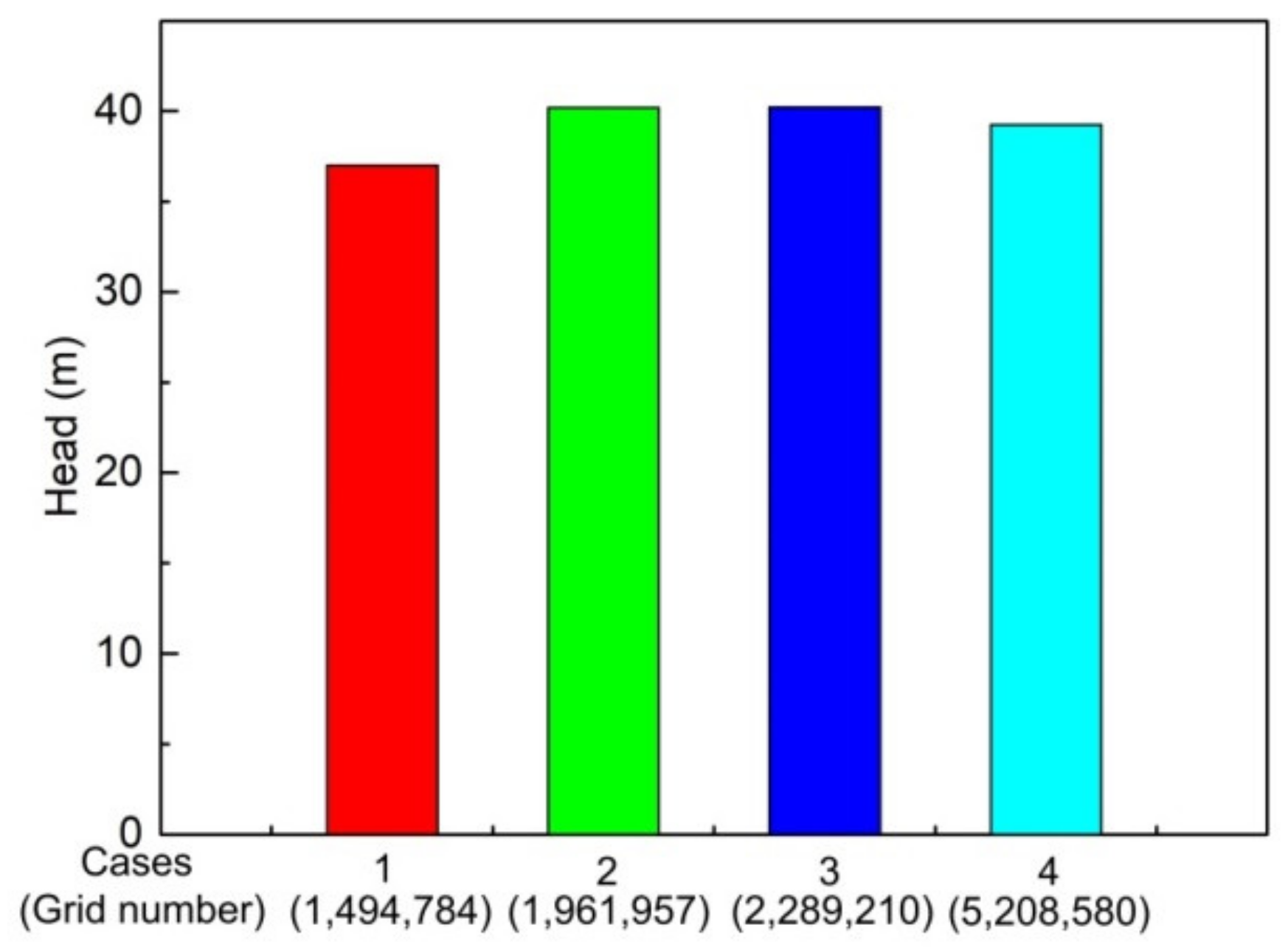

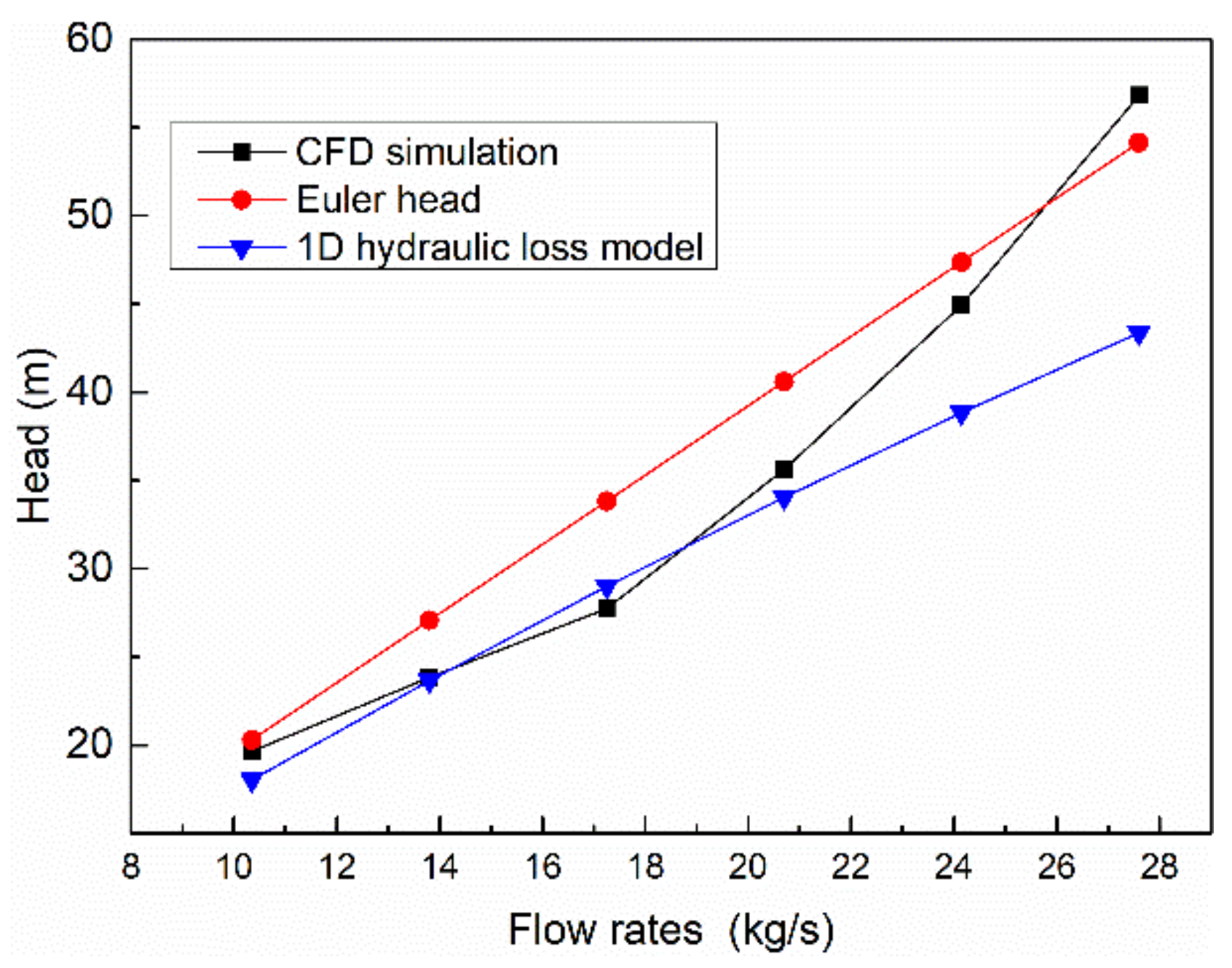
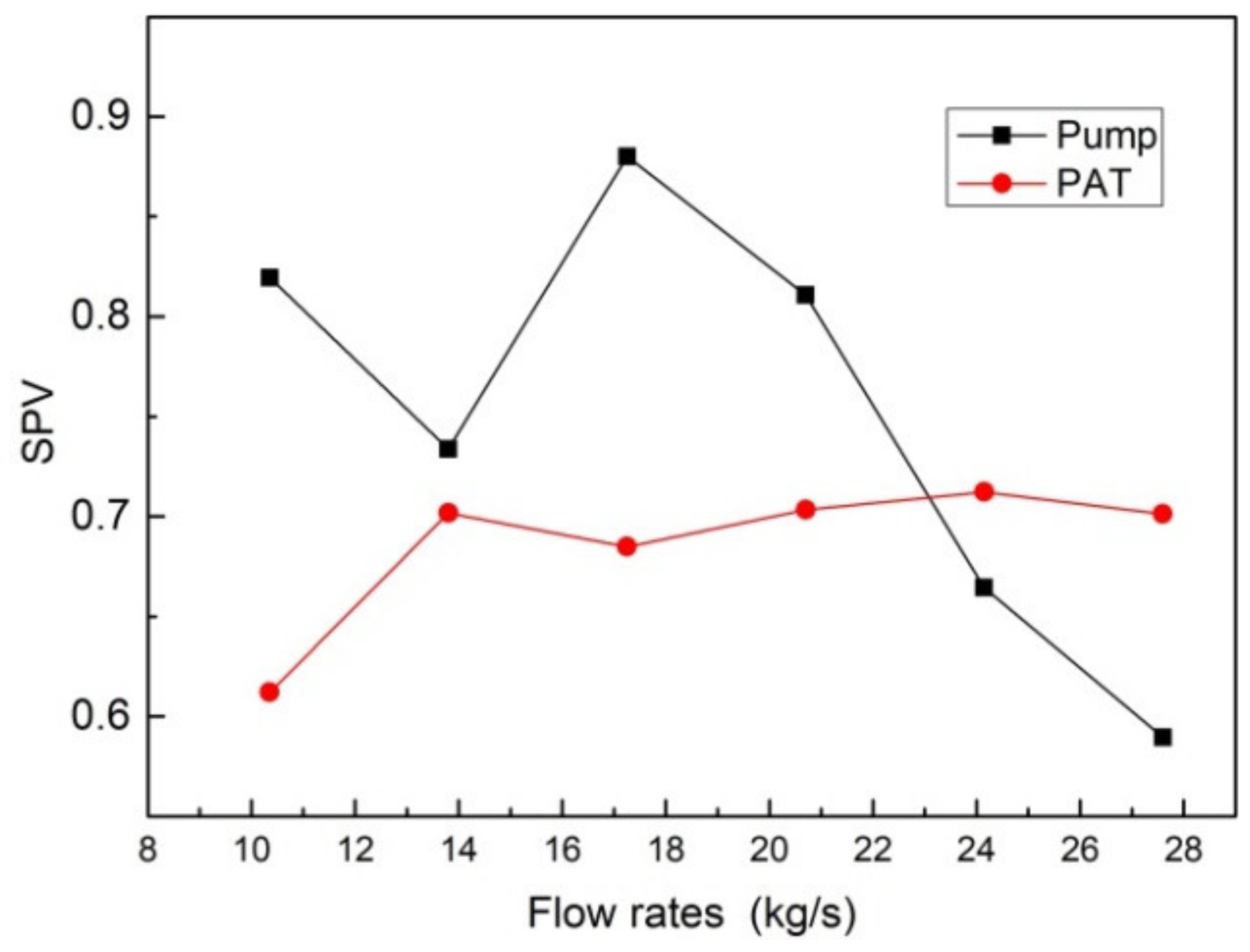
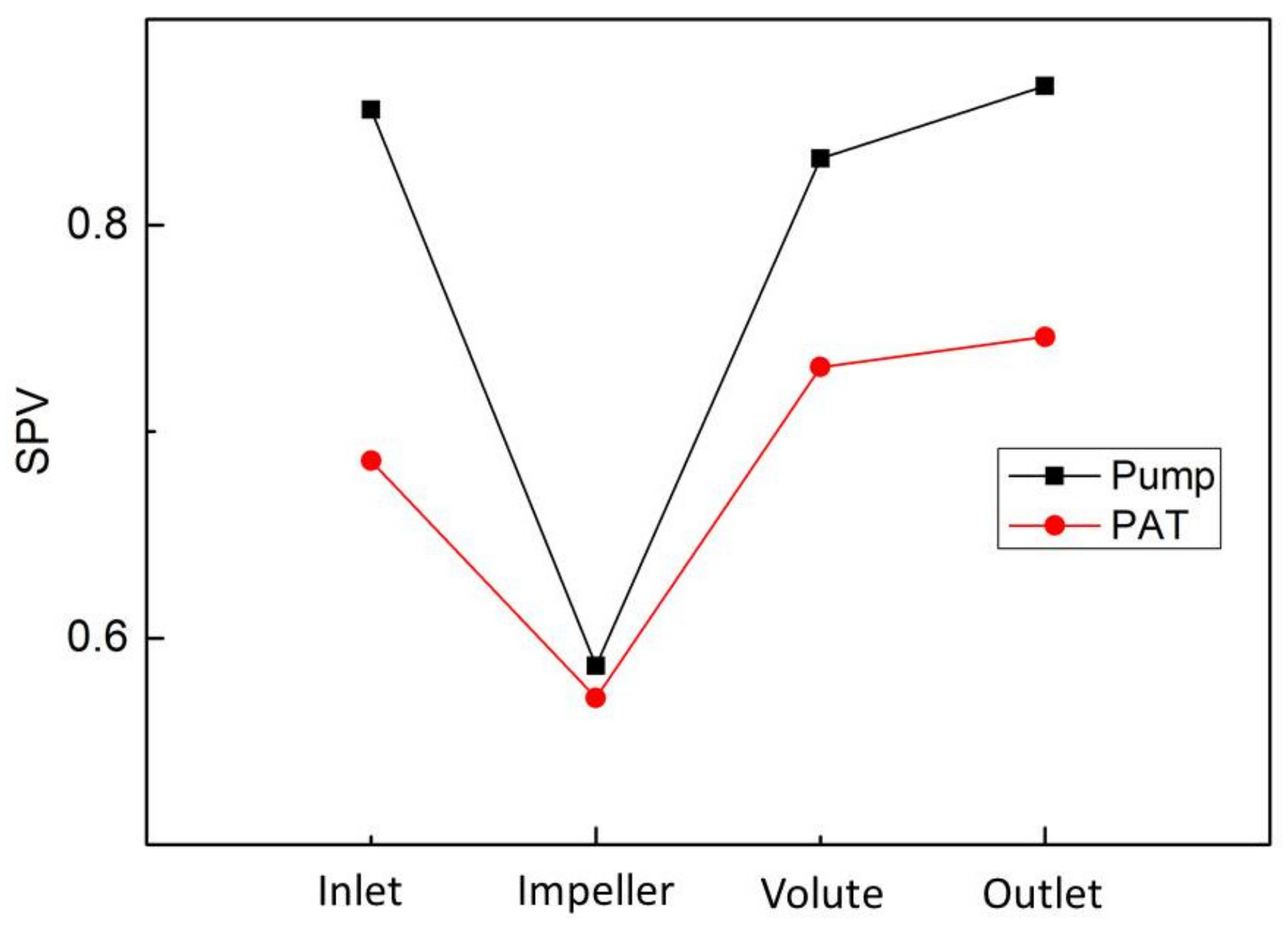
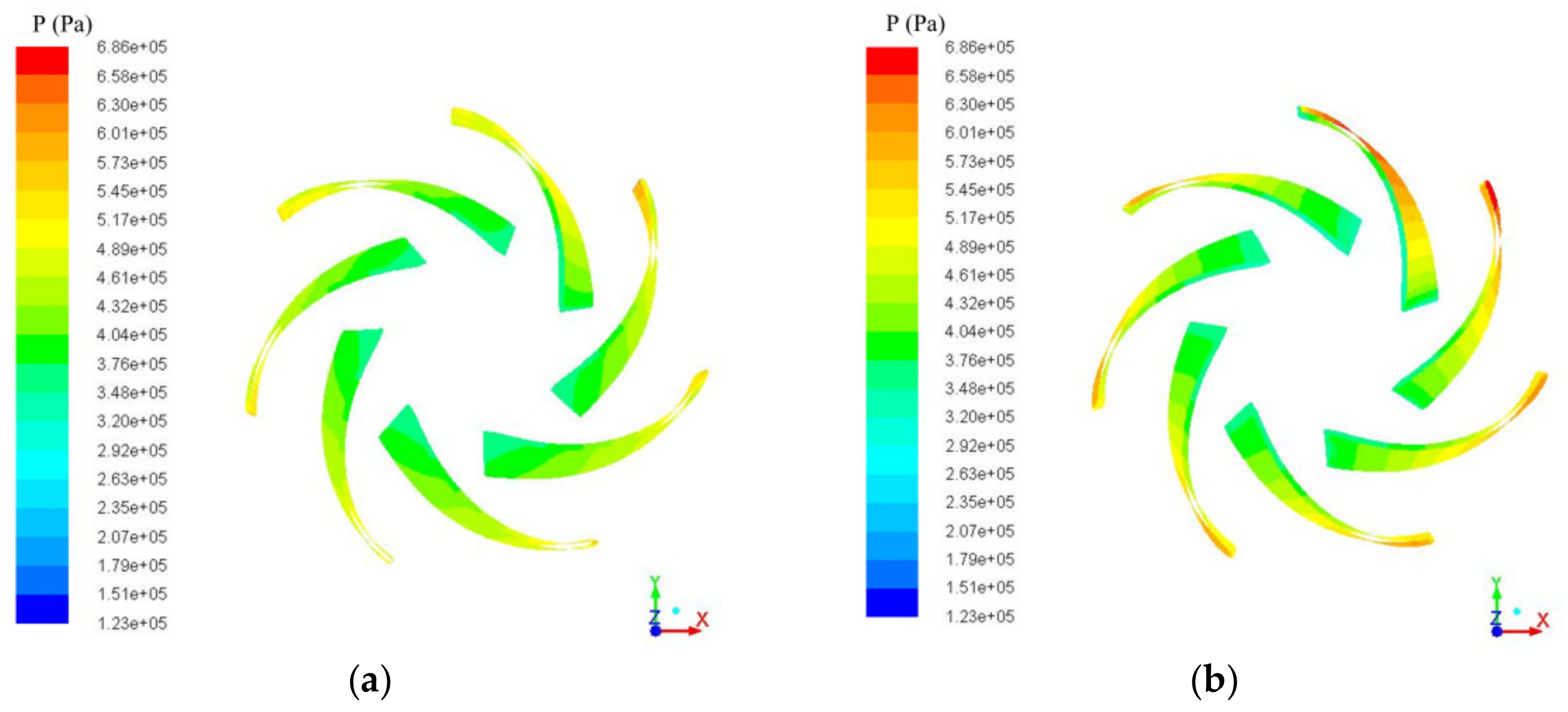
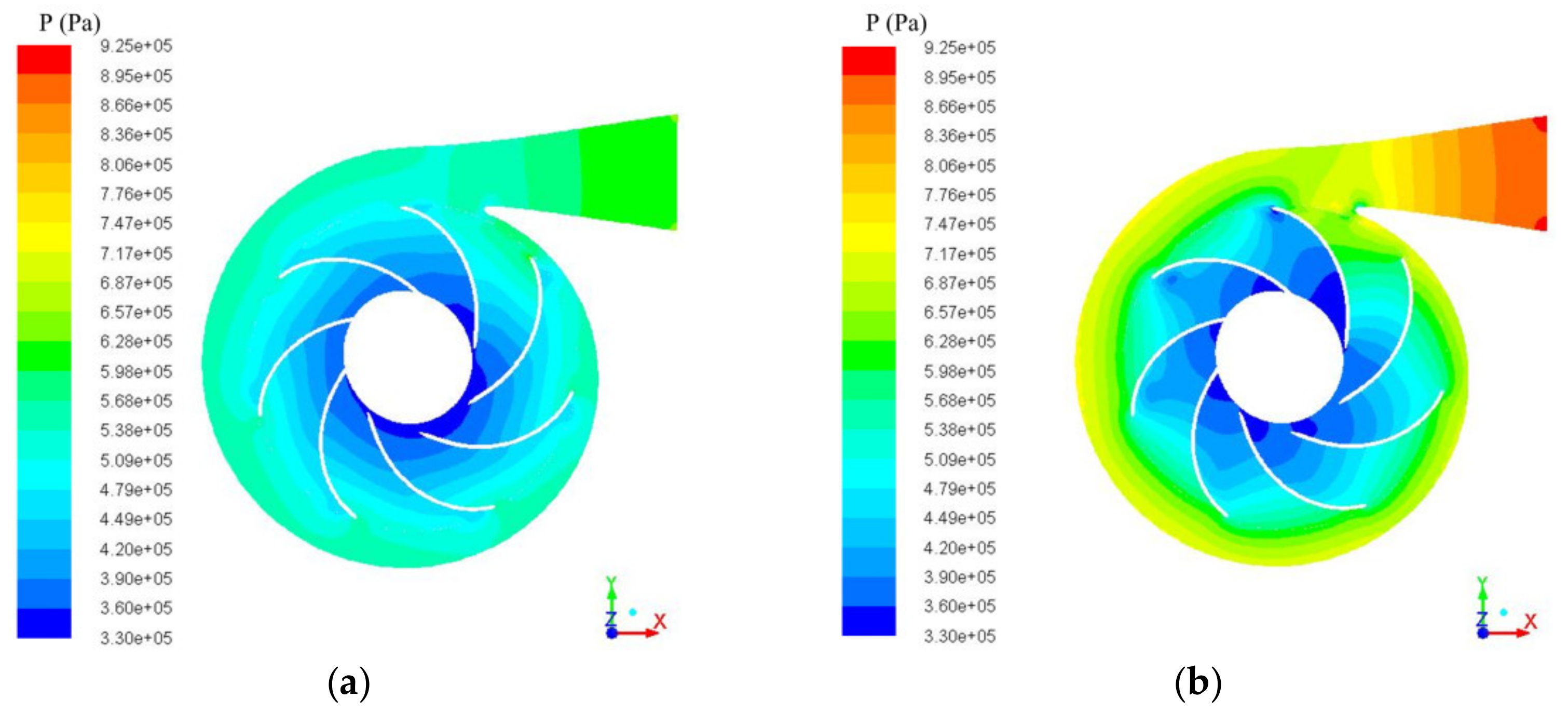
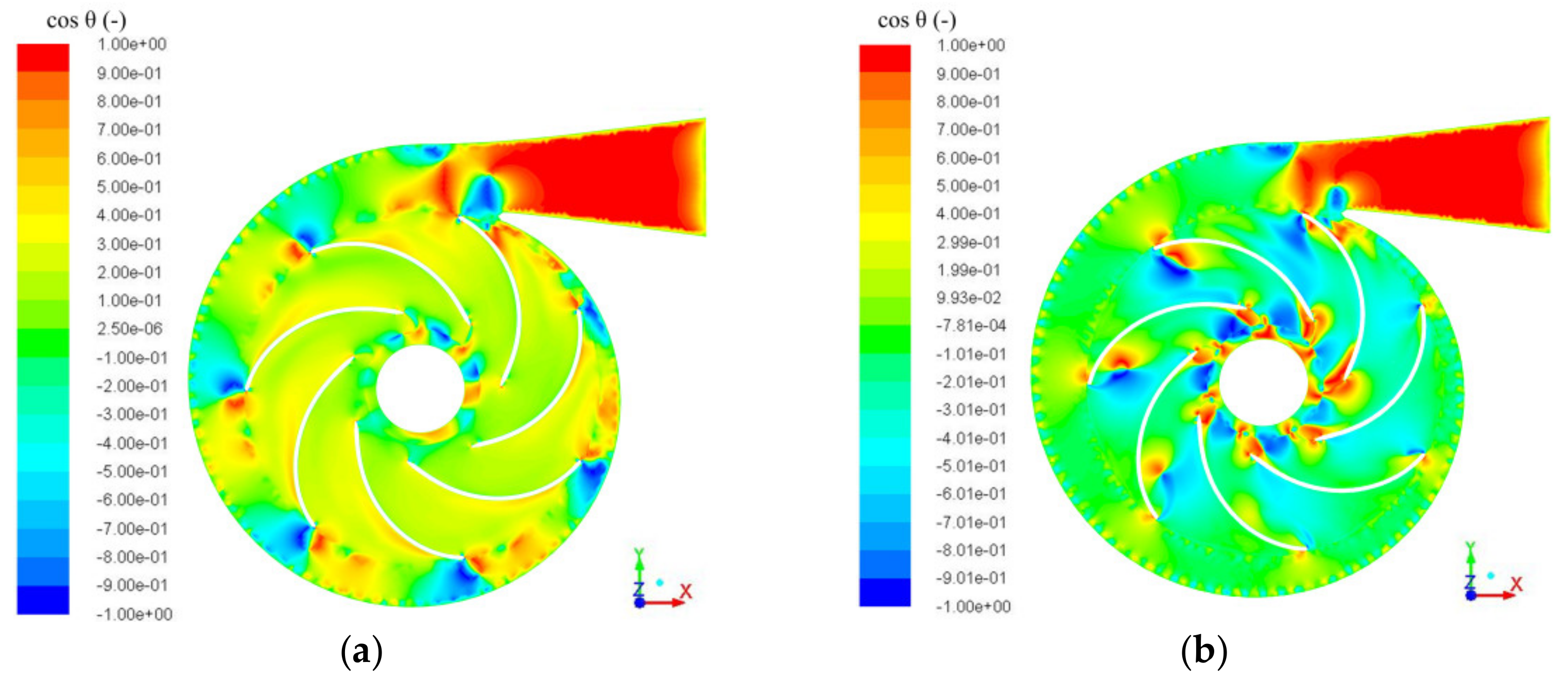
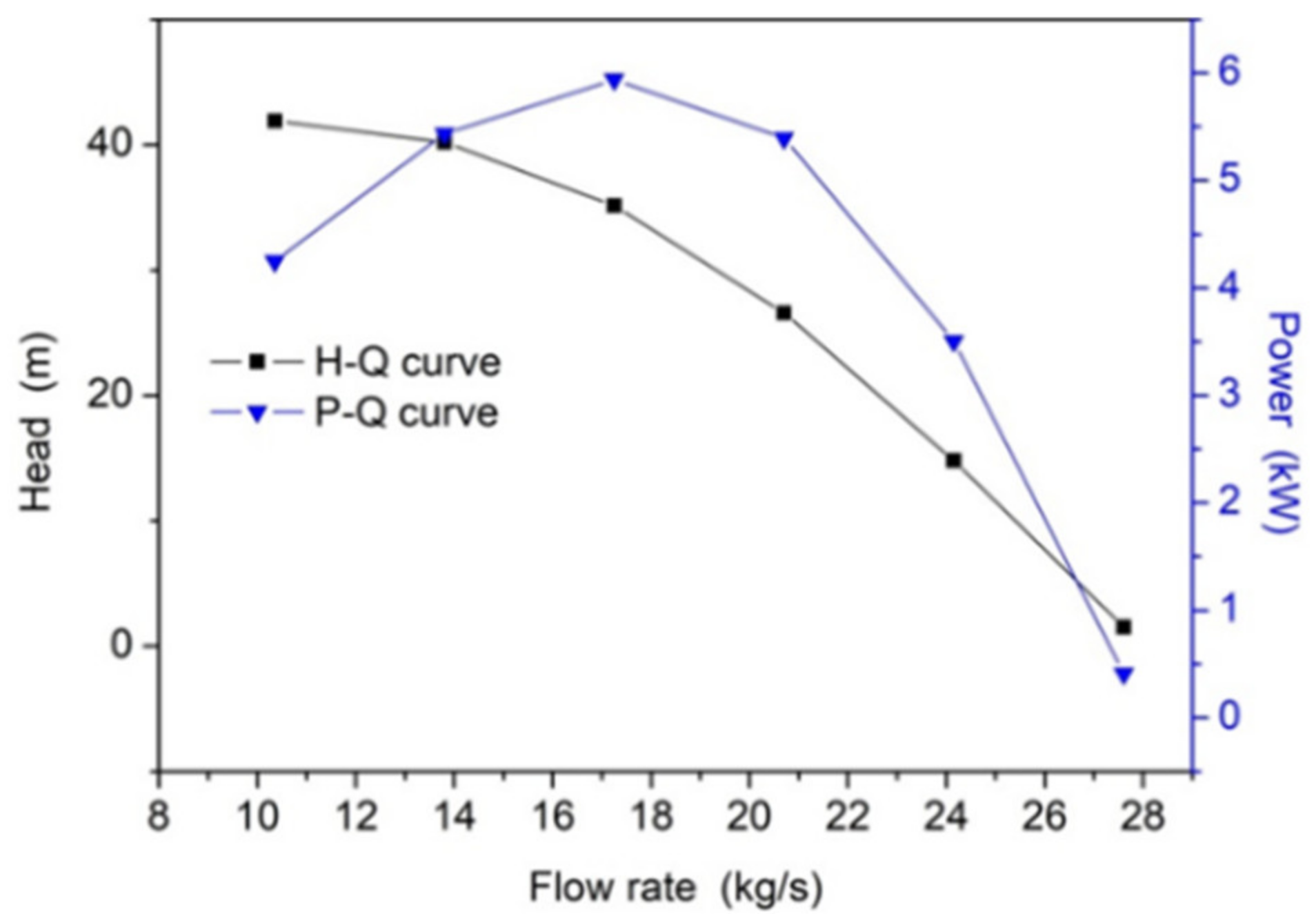
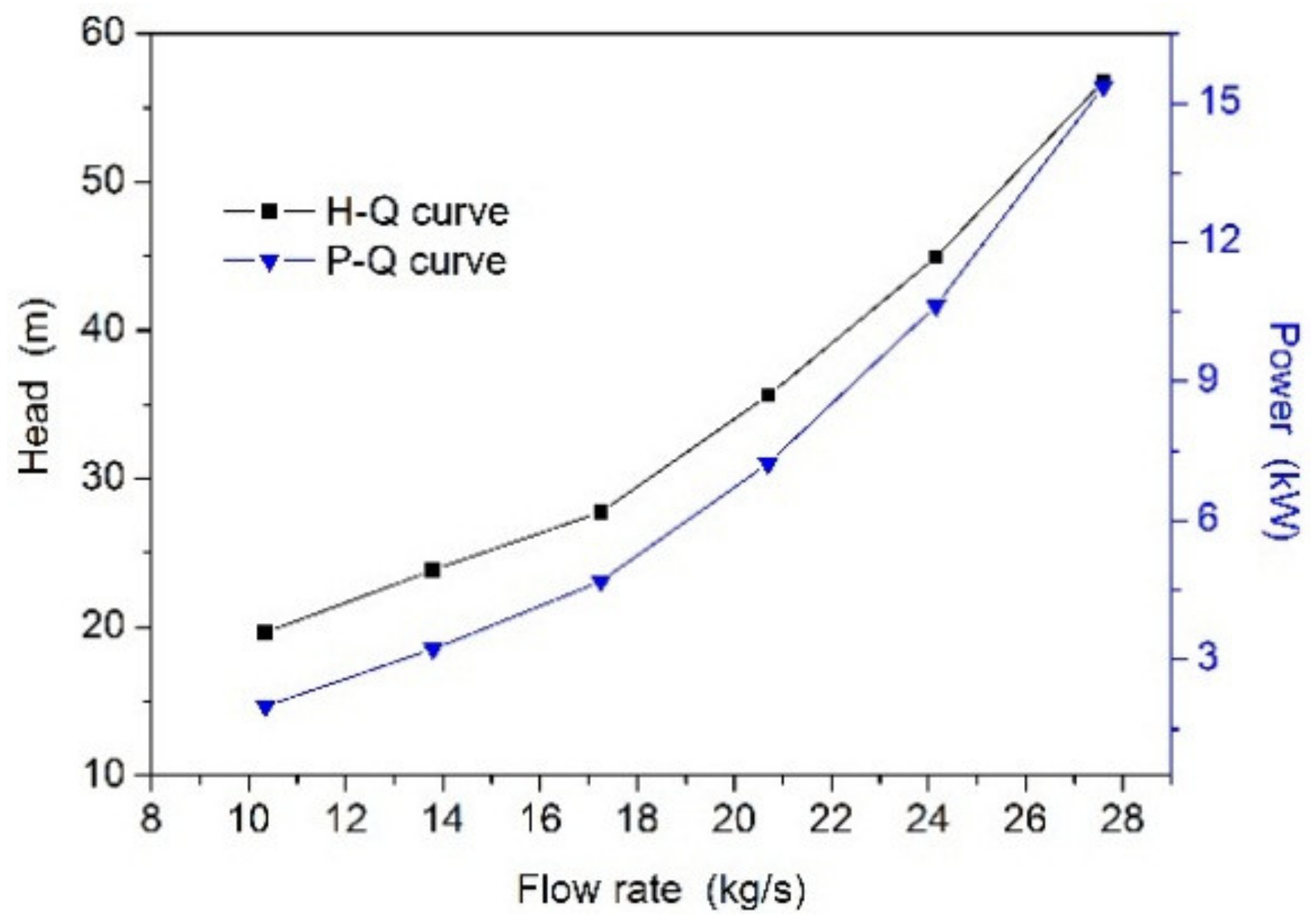

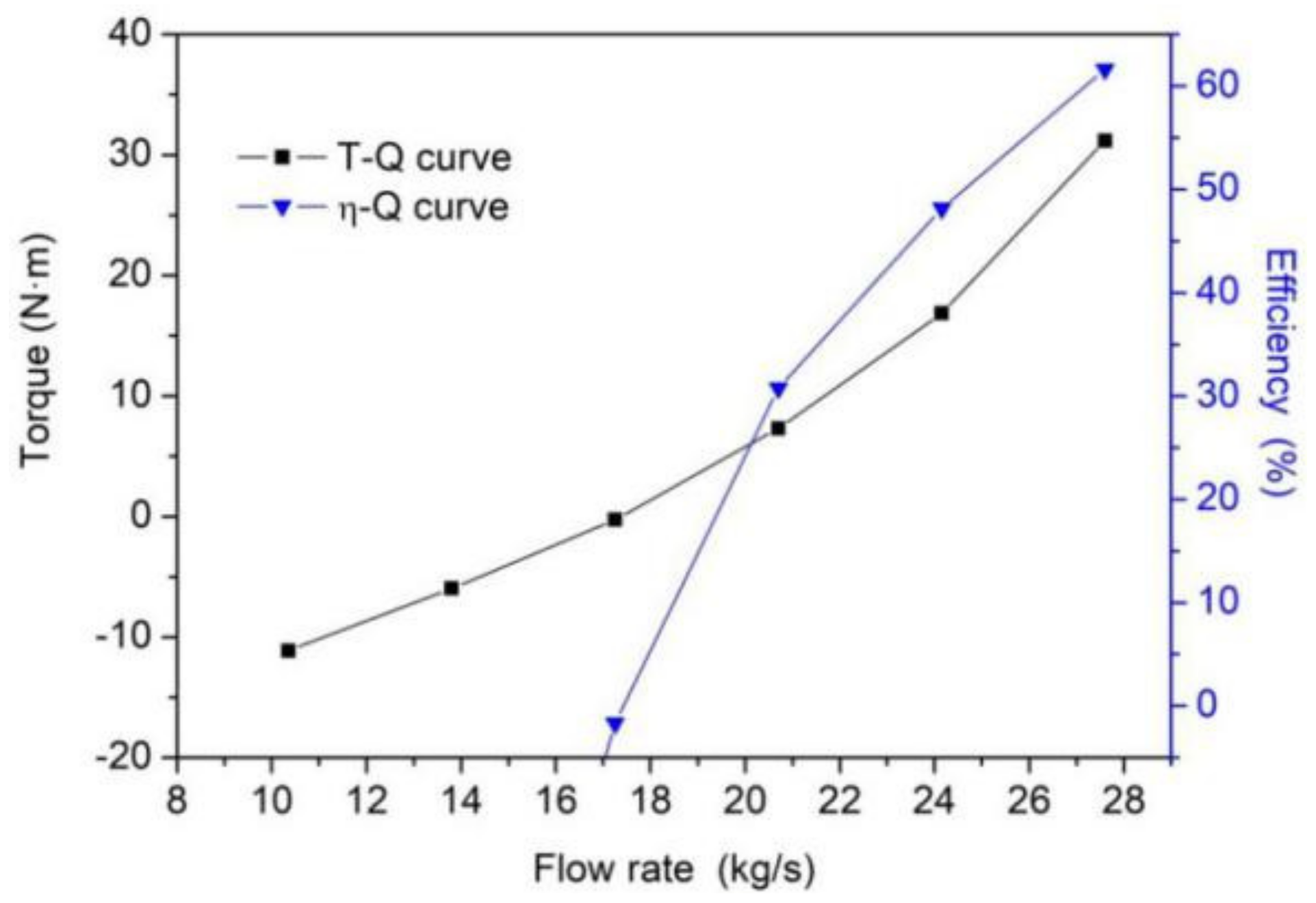

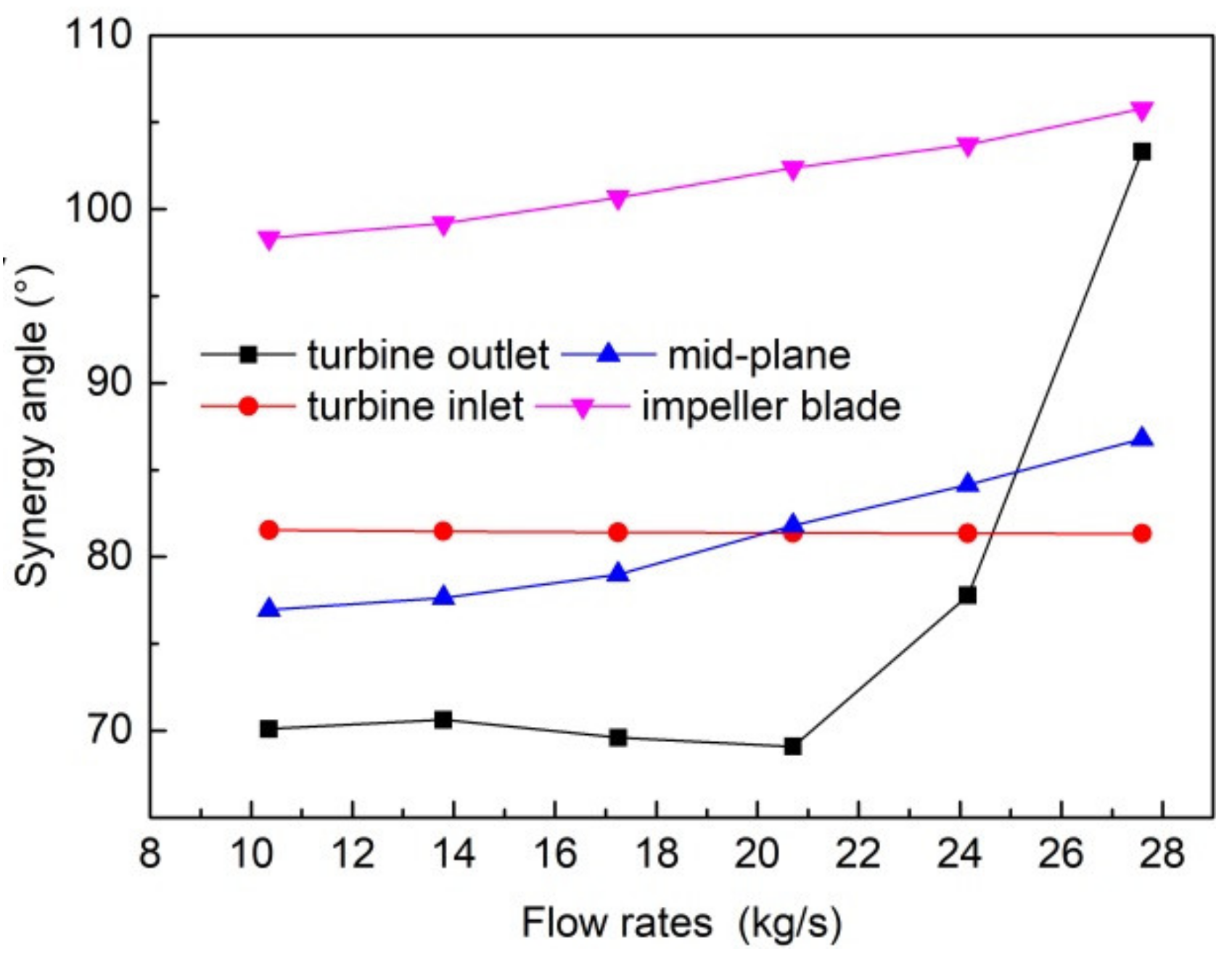
| Parameters (Unit) | Value |
|---|---|
| Impeller outlet diameter (m) | 0.165 |
| Impeller inlet diameter (m) | 0.092 |
| Blade thickness (m) | 0.02 |
| Hub diameter (m) | 0.03 |
| Number of blades (-) | 7 |
| Inlet blade angle (°) | 19.8 |
| Outlet blade angle (°) | 24.8 |
| Volute discharge area (mm2) | 996.4 |
| Volute width (m) | 0.033 |
Publisher’s Note: MDPI stays neutral with regard to jurisdictional claims in published maps and institutional affiliations. |
© 2021 by the authors. Licensee MDPI, Basel, Switzerland. This article is an open access article distributed under the terms and conditions of the Creative Commons Attribution (CC BY) license (https://creativecommons.org/licenses/by/4.0/).
Share and Cite
Cao, Z.; Deng, J.; Zhao, L.; Lu, L. Numerical Research of Pump-as-Turbine Performance with Synergy Analysis. Processes 2021, 9, 1031. https://doi.org/10.3390/pr9061031
Cao Z, Deng J, Zhao L, Lu L. Numerical Research of Pump-as-Turbine Performance with Synergy Analysis. Processes. 2021; 9(6):1031. https://doi.org/10.3390/pr9061031
Chicago/Turabian StyleCao, Zheng, Jianqiang Deng, Linkun Zhao, and Lin Lu. 2021. "Numerical Research of Pump-as-Turbine Performance with Synergy Analysis" Processes 9, no. 6: 1031. https://doi.org/10.3390/pr9061031
APA StyleCao, Z., Deng, J., Zhao, L., & Lu, L. (2021). Numerical Research of Pump-as-Turbine Performance with Synergy Analysis. Processes, 9(6), 1031. https://doi.org/10.3390/pr9061031







